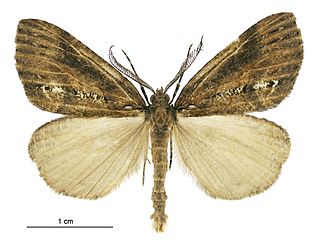
Chalastra ochrea is a moth of the family Geometridae. It is endemic to New Zealand. It has been observed in both the North and South Islands and inhabits native forest. Larvae of C. ochrea feed on the leaves of species in the genus Sophora including Sophora chathamica. Adults are on the wing from February until April. They have been collected via sugar traps.

Ichneutica blenheimensis is a species of moth in the family Noctuidae. It is endemic to New Zealand and is found throughout the North, South and the Stewart Islands. This species appears to prefer drier eastern localities and is rarely collected in western North Island forested areas. It does not appear to be frequently collected in inland dry tussock grassland habitats. The host plant for the larvae of this species is likely to be the golden sand sedge pīngao which is now absent from the moths type locality. However Chappell has raised very young larvae on grass species and the more developed larvae consumed Phormium tenax. Adults are on the wing from November to March and are attracted to both light and sugar traps. The blackish forewing fringes are diagnostic of this species. But worn specimens of I. arotis can be confused with worn specimens of I. blenheimensis. However I. arotis can be distinguished from I. blenheimensis as it has a scale-tuft on the thorax and dark longitudinal stripes on the tegula. This species is classified as "At Risk, Naturally Uncommon" by the Department of Conservation.

Chersadaula ochrogastra is a species of moth in the family Oecophoridae. This species is endemic to New Zealand. It is classified as "Data Deficient" by the Department of Conservation.
Orocrambus punctellus is a species of moth in the family Crambidae. It is endemic to New Zealand. It is classified as "Data Deficient" by the Department of Conservation.

Athrips zophochalca is a moth of the family Gelechiidae. It was described by Edward Meyrick in 1918 and is endemic to New Zealand. A. zophochalca has been observed in both the North and South Islands as well as at the Poor Knights. The species inhabits scrubby native forest, saline wetlands and braided river habitat. Larvae bore into the terminal shoots of Carmichaelia species. Adults are on the wing from November until March and are sexually dimorphic with the male lacking the white band on the forewings.
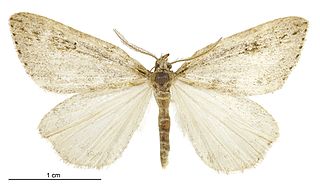
Pseudocoremia cineracia is a species of moth in the family Geometridae. It is endemic to New Zealand. It is classified as Nationally Vulnerable by the Department of Conservation.

Pseudocoremia lutea is a species of moth in the family Geometridae. It is endemic to New Zealand. It is classified as "At Risk, Naturally Uncommon" by the Department of Conservation.

Meterana pansicolor is a species of moth in the family Noctuidae. It is endemic to New Zealand. This species is classified as "At Risk, Naturally Uncommon" by the Department of Conservation.

Asaphodes imperfecta is a moth in the family Geometridae. It is endemic to New Zealand and is found in the southern part of the South Island. The species inhabits low lying swampy native forest. The host plants of the larvae of this species is unknown. The adults are on the wing in December and January. It is classified as critically endangered by the Department of Conservation.

Austrocidaria arenosa is a species of moth in the family Geometridae. It is endemic to New Zealand. This moth is classified as "At Risk, Declining" by the Department of Conservation.
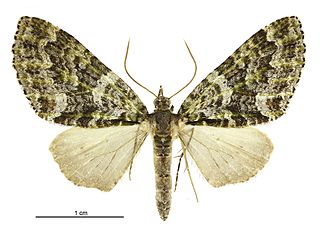
Tatosoma agrionata, also known as the mistletoe carpet moth, is a species of moth in the family Geometridae first described by Francis Walker in 1862. It is endemic to New Zealand. It is classified as at risk, declining by the Department of Conservation.
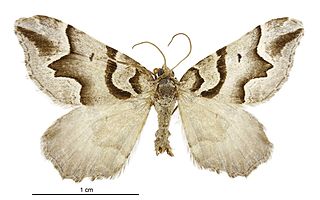
Helastia expolita is a moth of the family Geometridae. This species is endemic to New Zealand and occurs in the Buller, Marlborough, North and Mid Canterbury regions.This species inhabits short tussock grassland in montane to subalpine zones. Adult moths are nocturnal but little is known about the life history of H. expolita. Adults have been observed on the wing in November. It has been hypothesised the larvae of H. expolita feed on the flowers of Helichrysum species and then feed on mosses, lichens or shrubs growing nearby. It is classified as "At Risk, Relict'" by the Department of Conservation.
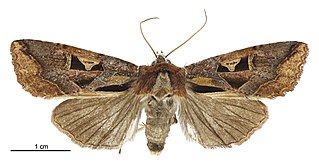
Meterana grandiosa is a species of moth in the family Noctuidae. This species is endemic to New Zealand. It is classified as "At Risk, Relict'" by the Department of Conservation.

Austrocidaria lithurga is a species of moth in the family Geometridae. It is endemic to New Zealand. This moth is classified as at risk, naturally uncommon by the Department of Conservation.
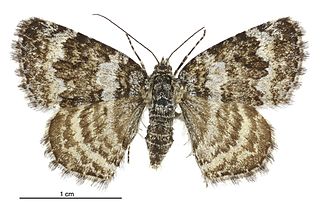
Dasyuris octans is a species of moth in the family Geometridae. It is endemic to New Zealand. This moth is classified as "At Risk, Naturally Uncommon" by the Department of Conservation.
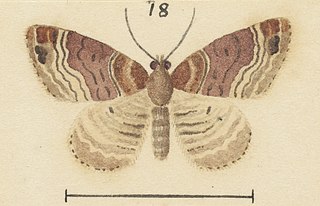
Hydriomena iolanthe is a species of moth in the family Geometridae. It is indigenous to New Zealand. This species is based on a single specimen that is now lost and has not been matched to any known species. As such it is classified as data deficient by the Department of Conservation.
Gymnobathra rufopunctella is a species of moth in the family Oecophoridae. This species is in need of taxonomic revision and probably belongs to a separate genus. It is endemic to New Zealand. It has been classified as Data Deficient by the Department of Conservation.

Asaphodes cinnabari is a species of moth in the family Geometridae. This species is endemic to New Zealand and can be found in Otago and Southland where it lives in alpine swampy habitat. Adults of this species are on the wing in November.

Asaphodes cosmodora is a species of moth in the family Geometridae. This species is endemic to New Zealand and has been observed in the South Island. The adults of this species are on the wing in January and February.

Asaphodes glaciata is a species of moth in the family Geometridae. This species is endemic to New Zealand. This moth has only be found in Westland in the areas near Fox and Franz Josef Glaciers. Adults of this species are on the wing in January.




















